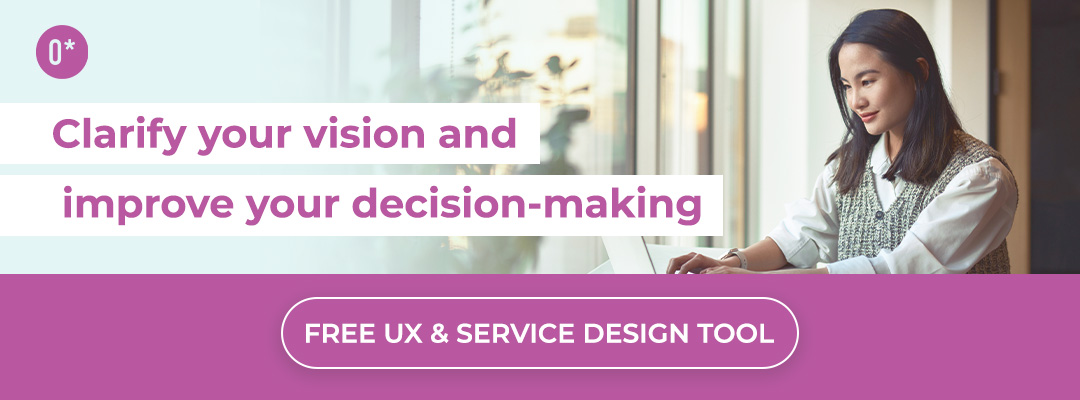
Everyone in UX, UI or service design is a creative type — yourself included! That’s true whether you’re curating colour palettes for wireframes, mapping out information architecture, reimagining the processes of a service, putting together a design research insights report or masterminding the operations of a complex project. And, like all creative types, you’ve probably had moments where you felt stuck or lost momentum.
The same way that writers famously get “writer’s block,” designers, researchers, strategists and even managers can sometimes get what we’ll call “designer’s block.” The good news is, we’ve had designer’s block too, and we’ve been brainstorming all the ways you can overcome it!
Today’s blog is all about getting unstuck and unleashing your creative flow in UX and service design work. We’ve sorted our top tips and techniques into two sections:
- 4 Ways UXers Get Stuck and How to Push Through
- 5 Steps to Finding Your Creative Flow
4 Ways UXers Get Stuck and How to Push Through
Sometimes, we sit down to do the most creative part of our jobs, the parts we usually find the most fulfilling… and then suddenly, minds go blank, and there’s no clear path forward. Does this sound familiar?
Depending on your working style, getting stuck can happen when you’re under lots of time pressure, or it can happen when work is slow and you suddenly don’t have enough time pressure to keep yourself focused. Whatever the case may be for you, we’re here to help.
Below, we’ve lined up the most common situations that cause our practitioners to get stuck, along with our favourite suggestions for getting unstuck!
If you’re…
- Stuck in synthesis:
Service designers, design researchers or any practitioners who’ve had to analyze data or synthesize it know that these crucial steps in the research process can feel the fuzziest and the longest. Synthesis involves swimming through piles of data while trying to find connecting patterns or themes. Keeping track of that much information at once is like acrobatics for your brain. It’s no wonder that we can find ourselves reading the same data points over and over again without getting anywhere!
Try…
Practicing mindfulness: We love a little bit of meditation in the middle of the day. Set an alarm on your phone so that you’re not constantly checking the clock, close or unfocus your eyes and start focusing on your breath for a couple of minutes, or more if you have time. This should help slow your thoughts down so that you can calmly examine each one without judgment and reexamine your research priorities. Not a fan of sitting still on your breaks? Try the same thing on a walk!
And…
Setting small goals: Once you’ve calmed your mind, you should return to your analysis or synthesis session with clear goals in mind. Break the process down into steps, and make each of these a mini goal to accomplish. For example, you could start by scanning just one interview’s worth of data, or you could start by looking for patterns around one specific pain point. Then move forward one increment at a time.
View this post on Instagram
If you’re…
- Coming out of a repetitive task loop:
Doing repetitive activities can sometimes be dizzying. Whether you’re working on something that involves a lot of repeating micro-tasks or you’re following the same script over and over again in a barrage of user interviews, it’s normal for your brain to start feeling a little fried. By the time you’ve completed these types of tasks, shifting focus to something more creative can be tough.
Try…
Changing up your routine: This could mean a change-up in your after-work life, like going for a meal and a venting session with a friend instead of parking yourself in front of the TV. It could also mean re-ordering your remaining priorities for the day so that you can focus on easier tasks until you’ve had some rest. OR, it could mean taking your break a bit earlier in the day so you can get some fresh air instead of waiting until you’re hungry for lunch. The bottom line here is: There are many benefits to shaking things up, including improved memory!
If you’re…
- Getting lost in design options:
UX and UI designers are celebrated for their capacity to create visually appealing prototypes and products that impress stakeholders and entice users. But staying consistent in this feat isn’t as easy as it looks! We can sometimes get lost in hyper-specific details, cross-referencing and comparing tens of variations of the same design with very slight differences. “Figma fever” sets in, and soon everything starts to look exactly the same. This feeling is enough to stop anyone in their tracks.
Try…
Looking away from your screen: The best antidote for indifference is new inspiration. Find a moment in your schedule to ditch your desk and get out into the world to look around. As you do, ask yourself questions like:
- What logos stand out most in your local mall?
- What products in your corner store look the most beautiful?
- What complimentary colors can you find in the trees at your neighbourhood park?
- Which passersby have the best outfits and why?
Or any other version of these questions! You get the gist.
(The idea here isn’t to try and copy what you see, of course, but to look at your options in a new way, pull yourself into a beginner’s mindset and bring that new perspective back to the drawing board with you.)
Or…
Asking a teammate for feedback: When you’ve been staring at your work for hours, your eyes can get so used to what you’re seeing that it’s harder to judge things impartially. A fresh set of eyes to help see things you might be missing. Reach out to someone you trust, and don’t worry if your work doesn’t look polished. A work-in-progress design is nothing to be ashamed of — it’s a beautiful and necessary thing. After all, that’s why prototyping exists!
(Note: If indecision is preventing you from finding a way forward in your UX project, Outwitly’s North Star PrinciplesTM can help! Click below to download a FREE ebook packed with pointers for developing clear, effective action plans that align with your goals.)
If you’re…
- Generating no new ideas:
The trickiest part about UX, UI and service design work is that eventually you have to actually design something! (Big surprise, right?) All of your time investments and your stakeholders’ financial investments are riding on this output, and that thought alone can be intimidating. Still, if you can get past it and get into ideation, there’s no guarantee that you’ll be happy with the first few (or many) ideas you come up with. All that exploring and diverging can get frustrating if it feels like it’s leading nowhere. So what now?
Try…
Creating in a different context: As a creative person, you probably have more than one outlet — maybe it’s knitting, painting, or writing, or maybe it’s a different type of design or storytelling, like character design, story illustration or even dungeon mastering. Whatever arts-based activities you enjoy, we recommend engaging in them in your spare time to help stimulate your creative mind.
David Epstein, author of The Range, discusses in his book how artists and innovators who dabble in more than one discipline become more agile thinkers and are able to “make connections their specialized peers can’t see.” Doing more of what you love AND having better ideas at work sounds like a great deal, doesn’t it?
5 Steps to Finding Your Creative Flow
UXers and service designers alike know that coming up with a great idea or action plan is half the battle at most. The execution of your ideas, and the intention, speed and flair you apply in that execution is what ultimately marks a successful UX or service design project.
Sometimes this process comes easily, and ideas flow through our fingertips quickly and blissfully. This concept of a “flow” state was coined by a well-known psychologist named Mihaly Csikszentmihalyi, who described flow as the secret to happiness, a mental state where you feel fully immersed in what you’re doing, where discouraging or distracting thoughts fall away.
But we’re not always so lucky as to find a flow state immediately. Sometimes, when we have this big idea staring us in the face, putting it down on the page feels like pulling teeth, and we just can’t seem to gain momentum.
That’s why we’ve put together a list of tried-and-true steps for getting into this productive mode. We hope they help!
1. Take care of your body: Make sure that you’re well-fed, hydrated, as well rested as possible and feeling comfortable in your workspace. This might seem like a given, but when we’re stressed and working to deadlines, we get in our heads and we often forget to check in and see how we’re feeling physically. Ask yourself, “Do I need to open a window for some cool air?” “Did I eat enough breakfast?” Your brain is part of your body, so you should make sure it’s set up for success.
2. Lean on your support system: One of the principles of flow, according to Csikszentmihalyi, is the need for balance between a person’s skills and the challenge presented to them. Sometimes, even when we have lots of experience and we’ve built amazing design portfolios, a lack of confidence can make that skills/challenge balance feel off.
If you’re worried that a task is just too difficult, why not ask a trusted teammate, close friend or family member for a pep talk and a confidence boost? People who know you well can remind you of how far you’ve come and how much potential you have.
3. Reaffirm your purpose: It’s also normal to lose steam if you’re not feeling challenged enough. UX and service design practitioners often have to keep repeating the same types of tasks, and after a long time, it’s possible to get a bit jaded. To overcome this, find ways to remind yourself of the reasons why your HCD work is so important. Check out any impressive work your coworkers are doing and read articles about groundbreaking products and services. Think about how you could innovate in the situation and top your last big success. (Sometimes your best competition is yourself!)
4. Minimize distractions: Put your phone away, put your notifications on “Do Not Disturb,” close your office door, use noise-canceling headphones, change your Slack status to “busy” — whatever you need to prime yourself for focusing. A flow state can only come to you when you’re able to fully concentrate.
5. Try to relax: There have been many scientific studies showing that stress can have a major effect on creativity. According to the American National Library of Medicine, a little bit of stress can motivate you, but a lot of stress can put you in a standstill, especially if that stress is caused by a perceived lack of control.
As we mentioned earlier in this post, meditation can play a part in calming the mind, but if that’s not your thing, we recommend giving these quick tricks a shot:
-
- Put on a playlist of your favourite music. It doesn’t have to be slow, calming music, if that makes you sleepy. Try a couple of different genres and see what works — some people need lyrics, some people need instrumentals only, etc.
-
- Create a relaxing ambiance. We love doing this through smell, by lighting a scented candle or pouring a cup of aromatic tea, but you might choose to work with your other senses. A cozy blanket or a change of lighting might help too — just make sure you can still see your work and you’re not harming your eyes.
- Create a relaxing ambiance. We love doing this through smell, by lighting a scented candle or pouring a cup of aromatic tea, but you might choose to work with your other senses. A cozy blanket or a change of lighting might help too — just make sure you can still see your work and you’re not harming your eyes.
-
- Shake out the nerves. We all know that physical movement helps with stress, but not everyone has time for actual running in the middle of an agile sprint! More and more yoga teachers and wellness coaches are recommending that you give yourself a literal shake. This involves shaking every part of your body and hopping up and down on the spot with total abandon for a few minutes. The key is to forget about how you look. The sillier you get, the more relaxed you’ll be.
If you follow these steps to a tee, we’re pretty confident that you’ll get into “the zone,” also known as that “flow” state, and start making design magic happen again. Just don’t forget to set an alarm before your next meeting, or you might lose track of time!
(Hey — Want to stay up to date on the latest trends, conversations and opportunities emerging in the UX and service design communities? Sign up for the Weekly Wit, Outwitly’s newsletter dedicated to UX and HCD topics!)
In the end, if you take just one message away from this blog, we think it should be: “Don’t get discouraged.” When you’re starting a new task from scratch, it’s easy to get overwhelmed and wonder where to start. And when you’re pushing through a longer design or research process, it can be easy to lose your sense of direction. A lack of ideas or flow can make you question your know-how and abilities. But there’s no reason for that!
Every artistic soul struggles with their work from time to time, especially in high-pressure work situations. The key to overcoming roadblocks is to stop, reassess, use your resources and persist. We hope that the tips and tricks above will guide you in this process and help you channel your creative genius.
We’ll leave it at that, but keep an eye out for Part 2 of this series on unblocking creativity, featuring the Outwitly team’s top strategies for finding inspiration in their work!





